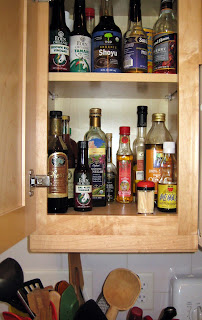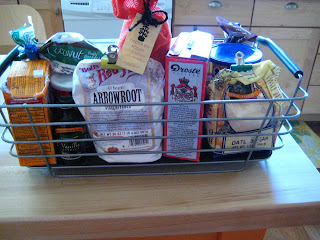I have been making a lot of squash soup and roasted squash this fall and winter and I wanted a slightly different presentation for a change. So, I decided to try this timbales recipe from the
New Vegetarian Epicure by Anna Thomas. I think this would be a great dish for a vegetarian Thanksgiving or Christmas feast; I wish I had noticed it earlier. Although, I found it tricky to unmold them and none of them came out in one piece. Maybe if I used real ramekins (as the dishes I used were too large) and had used finer bread crumbs that would have helped.
The
Sweet Red Pepper Puree that she recommends for garnishing it is also great as a dressing for salads, as I did for my
Fresh Green Garbanzo Salad. I also discoverd that the puree works well to cover up the flaws in the timbales if they don't unmold in one piece!
Timbales of Squash and Pears, adapted from The New Vegetarian Epicure
1 lb of peeled, cubed squash: Butternut, Tahitian, Kabocha, Hubbard or Acorn
1 lb of peeled, cubed yams or sweet potatoes
1 cup water
1/2 tsp salt
1 or 2 onions
2 1/2 Tablespoons butter
3 medium pears (firm but ripe)
1/2 cup good white wine
1/2 cup heavy cream or whole milk
5 eggs
white pepper to taste
butter and fine bread crumbs for the ramekins
1. Either braise or roast the squash and yams.
To Roast: Coat the cubes of squash and yams lightly with olive oil, sprinkle with salt, and roast in a pan in a 425 degree oven until tender, at least 30 minutes, stirring occassionally. (Omit the 1 cup water).
To Braise: Place the cubes of squash and yams in a heavy-bottomed pan with the water and salt. Cover and simmer on low until the vegetables are completely tender.
2. While the squash and yams are cooking, peel and chop the onions. Melt 2 tablespoons of butter in a skillet and cook the onions slowly, stirring often, until they are caramalized, uniformly golden brown.
3. Meanwhile, peel, core, and dice the pears into 1/4 inch or 1/2 inch cubes. When the onions are soft and brown, remove them from the pan and set aside. Add a bit more butter to the skillet and saute the pears for a few moments. Add the wine, cover tightly and simmer the pears on very low for about 15 to 20 minutes, until poached and tender. Turn on oven to preheat to 325 degrees F.
4. Place the cooked squash, yams, and onions in a blender or food processor with the cream or milk and puree until smooth. Lightly beat the eggs and whisk them into the vegetable puree. Season with salt and white pepper. Then stir in poached pears. (I didn't stir them in, I just placed them on top, as you see in the photo below: this was to illustrate better that there were pears in the dish, otherwise it wouldn't have been obvious).
5. Prepare 8 ramekins or timbale molds or custard cups or the such by buttering them inside thoroughly and then coating them with fine bread crumbs. Divide the squash and pear mixture evenly among the ramekins, filling them a little short of the top. Place the ramekins in a baking pan deep enough to hold water at least halfway up the depth of the molds. Bake that way (with water surrounding the ramekin dishes) in a preheated 325 degree F oven for about 50 minutes.
6. Unmold by sliding a thin knife around the edges of the ramekins and tipping each one onto serving plate. Surround each timbale with a small ribbon of
Sweet Red Pepper Puree and serve warm.














 When I am doing baking, I simply remove from my pantry the wire basket that holds my most-used baking products.
When I am doing baking, I simply remove from my pantry the wire basket that holds my most-used baking products. 















